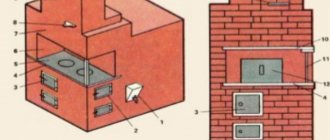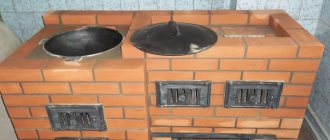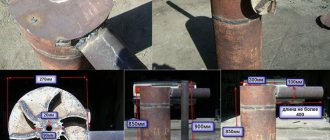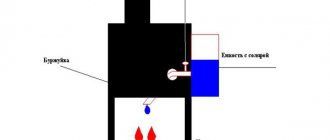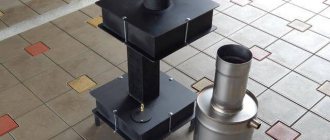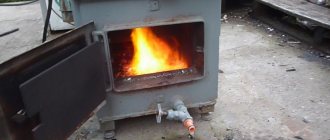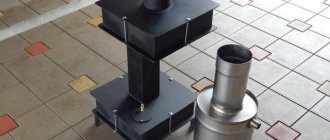This stove is a simple and convenient heating device that is superior to many others in terms of economy and efficiency. The quality of the stove is largely determined by its firebox, so its spherical shape is very advantageous (the firebox must have at least two holes, so a narrow, not very long cylinder is the best option)
several types of stoves from a gas cylinder , including a “rocket”. The rocket type design has many advantages over others.
Subtleties of operating an unconventional stove
A rocket furnace is heated in a similar way to a top combustion heat generator. It turns out that the kindling of equipment called a rocket must be carried out according to certain rules:
- the main raw material for heating the unit must be added only after the structure has been well heated, for which purpose sawdust or paper is first placed in the blower sector and set on fire;
- they must react to the muting of the hum emanating from the stove - they put a large batch of fuel into the combustion chamber, which will ignite on its own from the hot remains of sawdust;
- the process is closely monitored, that is, after laying the firewood, the damper is fully opened, and after some time, when the equipment makes a hum, it is closed to produce a sound similar to a rustling;
- as necessary, the damper is closed more and more, otherwise the firebox will be filled with an excess volume of air, which will disrupt the pyrolysis inside the fire tube and lead to the creation of a strong hum.
Since the jet stove was originally created for use in the field, its design is extremely simple. This allows an ordinary home craftsman to cope with the manufacture of the unit. But, despite its apparent lightness, the rocket stove must be assembled, taking into account the correct ratio of parameters. Otherwise, the equipment will be unproductive.
Assembling the stove with your own hands
Let's consider two schemes for building reactive furnaces with your own hands:
- Made of metal;
- Made from bricks.
Each of the presented structures is quite simple, so you don’t need any special skills to build it yourself.
Metal stove
- To build a metal jet stove with your own hands, you will need buckets, a stainless steel pipe and crushed stone.
- Make a hole in the bottom of the bucket for indoor installation for the pipe. A hole is made 2-4 cm from the bottom in order to fill the bottom with fine gravel.
- Place the pipe inside the first bucket. The pipe must have 2 elbows - for smoke exhaust and loading. The first is longer and the second is shorter.
- A hole is also made in the bottom of the second bucket and placed on the first bucket. Insert the head of the pipe so that the cut is 3-4 cm from the bottom.
- Fill the bottom of the lower bucket with crushed stone so that it reaches the middle of the height of the container. The crushed stone will accumulate heat and insulate the duct of your jet stove.
- Make a dish rack for your jet stove. To do this, you can weld several metal rods or use improvised gratings or steel mesh.
Brick stove
It is very simple to assemble a jet stove from bricks with your own hands. The order of the jet stove here is elementary.
- Lay out the first row continuous so that it covers the bottom. It is better to do this in the shape of a square, which will take you 4 whole bricks and one half. Another brick is placed on the side and will serve for more convenient loading of fuel into the firebox;
- Next comes a row for the stove of 3 solid bricks and 1 half. The center should be empty. This will be the bottom of your firebox;
- Lay out 3 more rows of jet stove bricks with whole pieces each. You should end up with a design with a square hole in the center;
- Such a scheme ensures the creation of a reactive stove with a vertical loading channel from 20-25 bricks.
The jet furnace is distinguished by its elementary design in the simplest models. If you need to quickly build a stove from scrap materials, a rocket is one of the best options.
Yes, jet stoves are not without their drawbacks. But tell me, which oven doesn’t have them?!
Tools
To build a rocket stove for a garage with your own hands, you will need a set of tools and accessories consisting of:
- a household apparatus for electric welding with electrodes with a diameter of 3–4 mm;
- grinders or hacksaws for metal;
- hammer - slag separator;
- an ordinary hammer;
- pliers;
- chisels;
- metal brushes;
- electric drill;
- measuring instruments: tape measure, level and plumb line;
- marker or chalk;
- personal protective equipment: protective mask, dielectric gloves, protective clothing made of thick fabric and closed shoes.
DIY rocket furnace construction
It is not difficult to build a jet stove yourself. First you need to select the design option that suits you and make a drawing. If necessary, you can use ready-made diagrams made by professionals. Many are captivated by the ease of manufacturing a rocket stove and the ability to do without the use of expensive materials. If necessary, a rocket stove can be made even in 20–30 minutes, for example, from an iron can. However, if you make every effort, it is possible to get a comfortable stationary structure for the relaxation room in the bathhouse with a heated couch that can replace an ordinary sofa. At the same time, the “rocket” will not require complex arrangements, like bell-type or Russian stoves, which are massive structures.
Rocket stove made from a gas cylinder
To make this rocket stove you will need such a kit.
- A used 50 liter gas cylinder with a cap.
- Pipe with a diameter of 150 mm for the fuel and loading chambers.
- Pipes with a diameter of 70 mm and 150 mm for the riser (primary vertical chimney).
- Non-flammable insulation.
- 100 mm pipe for the exhaust chimney.
Cut off the top of the balloon. Openings for the firebox and chimney are cut out on the sides. The firebox pipe is connected to the riser at an angle of 90 degrees. The primary vertical chimney consists of two pipes of different diameters threaded into each other, the space between which must be insulated. Calcined sand can be used as insulation. All parts of the rocket stove are carefully welded together.
Do not forget to weld the cut top of the gas cylinder back after installing the internal elements of the rocket stove. If necessary, you can make a more powerful jet unit using a standard two-hundred-liter barrel as a cap. At the same time, the dimensions of all stove elements increase.
Stationary brick oven with bench
To build a rocket stove with a place to rest, you must adhere to a certain rule: the dimensions of this model depend on the diameter and cross-sectional area of the cap that covers the riser. Based on this:
- the height of the cap is equal to 1.5–2 parts of its diameter;
- the height of its coating with clay is equal to 2/3 of the height of the cap;
- thickness of clay coating – 1/3 of the diameter of the cap;
- the riser area is 5–6% of the cap area;
- the gap between the inverted bottom of the cap and the upper edge of the riser must be at least 7 cm;
- the length of the horizontal section of the firebox is equal to the height of the vertical primary chimney;
- the blower area is 50% of the riser area;
- the external chimney has a size equal to 1.5–2 the cross-sectional area of the hood;
- the thickness of the adobe cushion under the horizontal chimney is 50–70 mm;
- the thickness of the adobe mortar of the bench is equal to 0.2–0.5 of the diameter of the cap;
- the height of the chimney should be raised above the firebox by 4 m, which will ensure sufficient draft in the stove.
When the cap is made from a two-hundred-liter barrel, then the stove bench is made up to 6 m long. And if from a gas cylinder, then the horizontal chimney should not be longer than 4 m. And do not forget to take care of the quality of the riser lining. For this, light fireclay bricks are used. River sand, which must be clean, is also suitable.
Stove with bench
Other rocket stove designs
A small-sized “rocket” made of brick is another simplest option for building a stove of this type with your own hands. No cement mortar is required for its assembly. It is enough to stack the bricks on top of each other. There are also models of rocket stoves with a water jacket, which allow not only to heat the room, but also to provide the owner with hot water.
The components of reinforced concrete are not cheap and a concrete mixer is needed for mixing. But its thermal conductivity is much lower than that of other units. The new rocket stove began to work more stable and it became possible to release some of the heat outside in the form of infrared radiation through heat-resistant glass. The result was a rocket stove-fireplace.
Next step: connecting the cylinders to each other
I consider this work to be the most important. Laying the cylinder on its side, I used a marker to mark a rectangle on it, 10 cm wide over its entire length.
Of course, it can be made shorter, but it seemed to me that this would be better for the operation of the potbelly stove. The marked area was cut out, and the part of the metal removed after this work was divided into two equal halves in length. It was from them that I made the transition from one cylinder to the second. This is very convenient and eliminates the need for unnecessary measurements and searching for additional material. A similar slot was made in the second cylinder, but the separated strip was used later for other purposes. It was from this that the plugs on the sides of the adapter from one cylinder to the second were made.
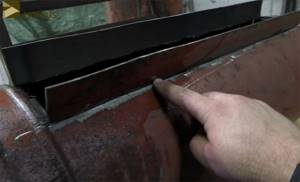
This is what a slot with side walls should look like:
Manufacturing recommendations
The easiest way is to make a small portable stove with your own hands - the Robinson rocket, whose drawing is presented below. You will need cutting profile pipes, metal for legs and stands, as well as welding skills. Moreover, compliance with the exact dimensions indicated in the drawing is not necessary. You can take pipes of a different section, but you just need to reduce or increase them proportionally so that the parts fit together.
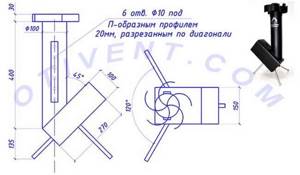
Drawing of an improved “Robinson” camping stove with nozzles made of a profile pipe, cut lengthwise into 2 parts
The most common versions of large rocket stoves are made from a gas cylinder or a two-hundred-liter metal barrel. You must understand that these ready-made elements are used as an outer hood, and the internal parts of the stove must be made from pipes of smaller diameter or laid out from fireclay bricks. Moreover, from a cylinder you can make both a stationary heater with a small bench, and a unit that can be moved.
Please note that calculating the thermal power of a rocket-type furnace is quite difficult; there is no single calculation method. It’s easier to rely on ready-made drawings of already working samples and assemble according to them. You just need to compare the dimensions of the future stove with the dimensions of the heated room. For example, to heat a small room, the size of a cylinder is enough; in other cases, it is better to take a large barrel. The selection of internal parts for them is shown in the diagram:
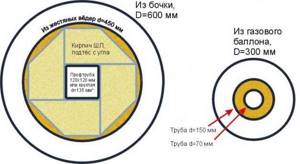
2 options for potbelly stoves - from a gas cylinder and a standard iron barrel
Stove rocket from a cylinder
In addition to the gas cylinder itself, to assemble the stove you will need:
- profile pipe 150 x 150 mm for the firebox and loading hopper;
- steel pipes with a diameter of 70 and 150 mm will go to the internal vertical channel;
- the same with a diameter of 100 mm for the chimney;
- insulation (basalt fiber with a density of at least 100 kg/m³);
- sheet metal 3 mm thick.
For a master skilled in welding, this work will not be particularly difficult. The top of the cylinder should be cut off along the seam, after first unscrewing the valve and filling it to the top with water. Openings are cut on both sides for installing a firebox and inserting a chimney. A profile pipe is inserted and connected to a vertical channel, which is discharged through the bottom of the cylinder. Further work on the manufacture of the rocket furnace is carried out in accordance with the drawing:

At the end, the upper part must be welded into place, then carefully check all seams for permeability so that air does not flow uncontrollably into the oven. After this, you can attach a chimney with a water jacket (if available) and begin testing.
Masonry of a rocket-type heater made of bricks
This stove option will require the purchase of fireclay bricks; ordinary ceramic bricks will not work for a rocket stove. The masonry is done using fireclay clay mortar; it is also sold as a ready-made building mixture. How to make a stationary rocket stove:
- First you need to dig a hole, compact the bottom and pour a foundation measuring 1200 x 400 mm and 100 mm high, as shown in the photo.
- After hardening, the foundation is covered with a sheet of basalt cardboard and the combustion chamber, a bunker for loading firewood and a vertical channel are laid. A door is installed at the end of the combustion chamber to clean the ash pan.
- After the clay has dried, the pit is filled up, and a pre-selected pipe or small barrel with a diameter of 450 mm is placed on the vertical channel. The gap between the brickwork and the pipe walls is filled with fire-resistant insulation, for example, basalt wool, expanded clay, vermiculite.
- At the last stage, a cap made of a large metal barrel with a diameter of 600 mm is put on the structure. First, a cutout is made in its upper part and a pipe is installed to connect the chimney. When the barrel turns over, he will be at the bottom.
Then it’s a matter of technology; you can take the chimney directly outside or build another bench with smoke circulation. For this purpose, ordinary ceramic bricks and clay-sand mortar will do. The order of the brickwork of a rocket stove with a small bench is shown in detail in the video:
Jet stove - what is it?
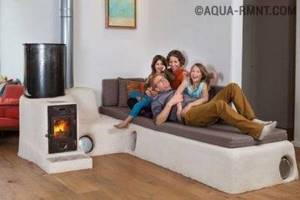
The home heat that comes from a jet stove cannot be provided by any modern heater.
A jet stove, or, as it is also called, a rocket stove, actually has nothing in common with modern technologies. The only thing that makes this heating unit look like a space vehicle is the intense flow of flame and the humming associated with improper operation. Nevertheless, it cannot be said that the rocket stove is a completely backward device in technical terms. Despite its simple design, it uses the most advanced methods of burning solid fuels:
- pyrolytic combustion of gases released during dry distillation of solid fuel;
- movement of gaseous products through the furnace channels, which does not require forced ejection due to draft.
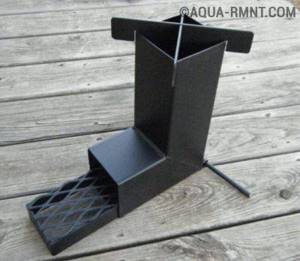
This is what a simple jet-powered stove looks like
The simplest “rocket” is a curved piece of large diameter pipe. Firewood or other fuel is placed in a short horizontal section and set on fire. At first, the heating device works like an ordinary potbelly stove, but this is only until the temperature of the longer vertical part, which acts as a chimney, rises. The red-hot metal promotes the re-ignition of flammable substances and the appearance of a vacuum at the top point of the chimney. Due to increased draft, the air flow to the firewood increases, which significantly increases the burning intensity. In order to achieve even greater efficiency from this original device, the firebox opening is equipped with a door. When the cross-section of the air channel decreases, the supply of oxygen to the firewood stops and its pyrolytic decomposition into gaseous hydrocarbons begins. But in such a simple installation they will not burn completely - for this you will need to set up a separate area for afterburning the flue gases. By the way, it is this, as well as the thermal insulation of the chimney, that allows more complex “rockets” to successfully compete with other solid fuel units. As for the simplest design we are considering, it is often used for cooking or heating food. All that is required for this is to equip a convenient platform for a pot or kettle on the vertical section of the stove.
Geography of application of rocket heating units
Being a simple and convenient heating and cooking unit, the rocket stove is widely used in both mobile and stationary versions. Most often it is used:
- for heating residential premises;
- as equipment for drying fruits;
- for heating greenhouses;
- to ensure normal working conditions in workshops or garages;
- to maintain above-zero temperatures in warehouses, utility buildings, etc.
Thanks to its simplicity, unpretentiousness and reliability, the jet heater enjoys well-deserved respect among fishermen and hunters, car rally enthusiasts and survivalists. There is even a special version, the purpose of which is indicated by the name - “Robinson”.
Advantages and disadvantages of the rocket stove
Despite its simple design, the rocket stove has many advantages:
- efficiency level at the level of the best examples of modern heating equipment operating on solid fuel;
- efficiency - to achieve the required temperature, the jet unit will consume four times less firewood than a traditional stove;
- heating temperature above 1000 °C;
- the ability to use any type of solid fuel, including dry plant waste, cones, pine needles and shavings;
- complete combustion and environmental friendliness - during operation, the flame temperature increases so much that the soot ignites. Rocket stove smoke consists primarily of water vapor and carbon dioxide;
- possibility of additional fuel loading for continuous operation of the heating device;
- simplicity and reliability;
- the presence of portable structures intended for mobile use.
The heating unit is not without its drawbacks. Operation of the device is associated with the risk of carbon monoxide entering the home. The stove cannot be used to heat a large house, and attempts to install a water heat exchanger in the combustion zone lead to a decrease in thermal power and disruption of normal operation. The disadvantages include the low aesthetic value of the design, which, however, is a very ambiguous statement, since for lovers of ethno-style, the design of the stove is a real find.
Types of jet heating devices. Choosing a design for self-production
Craftsmen have developed several designs of rocket stoves suitable for mobile or stationary use:
- portable units made of metal pipes, cans or buckets;
- jet heating devices from a gas cylinder;
- ovens built from fireclay bricks and metal containers;
- heating heat generators with a stove bench.
The most difficult to manufacture are the structures, the construction of which requires the skills of a mason. However, if you have detailed diagrams of serial layouts, even a novice home craftsman can handle this work.
Portable rocket stove
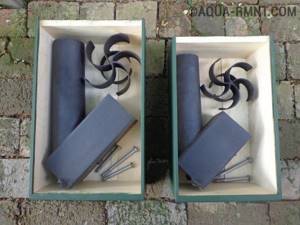
Portable rocket stoves are mass-produced by industry
Hiking options are represented by the simplest designs, which are based on the same pipe bent or welded from individual sections. The improvements affected only the installation of a partition for arranging the ash pit, in which a slot is made for air leakage. Often the lower part of the loading chamber is equipped with a grate to supply air directly to the combustion zone. The opening for storing firewood is equipped with a door, which subsequently regulates the air supply.
The requirements for a mobile design also extend to convenience during cooking, so the upper section of the chimney must be equipped with a stand for metal utensils.
Gas cylinder unit
The use of a gas cylinder is the next step in the development of jet heating devices. A more complex design can significantly increase the thermal power and efficiency of the furnace. All that is required to make the installation is a household gas cylinder or fuel barrel, sections of thick-walled steel pipes and a metal sheet 3–5 mm thick.
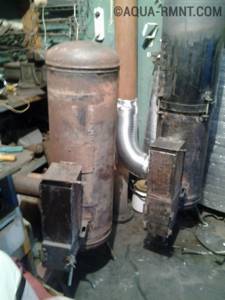
A rocket stove made from a gas cylinder can be used to heat small utility rooms
If you have a piece of steel pipe with thick walls and a diameter of more than 30 cm, a rocket stove can be made from it. This option will allow you to avoid labor-intensive operations associated with disassembling the factory gas tank.
How such a design works can be seen in the diagram below. Firewood loaded into the firebox burns due to the flow of air through the loading window. Afterburning of combustible gases occurs in a pipe installed inside the cylinder due to the supply of secondary air. To enhance the effect, the inner chamber is insulated, which makes it possible to raise the temperature inside above 1000 °C. Hot gases hit the bell as they move and enter the outer chamber, the walls of which act as a heat exchanger. Having given up their energy, the combustion products are discharged through a chimney cut into the lower part on the back side of the cylinder.
To create the draft necessary for stable operation of the rocket stove, the top of the chimney is raised at least 4 m relative to the loading window.
Combined rocket stove made of brick and metal barrel
The use of fireclay bricks for arranging the firebox and internal chambers of a jet heating device transforms the “rocket” into the category of stationary structures. The high heat capacity of the materials used allows heat to be accumulated and released within several hours, which is why such units are often installed in residential premises.

Furnace structure with refractory lining of the working area
Jet stove with stove bench
Like other solid fuel stoves, the "rocket" has the disadvantage that most of the heat is lost through the chimney. Despite this, certain advantages of its design make it easy to get rid of this disadvantage. The thing is that the unit was called reactive for a reason, but because of the high rate of excision of burning gases. This feature can be turned into a benefit by significantly increasing the length of the smoke exhaust channels.
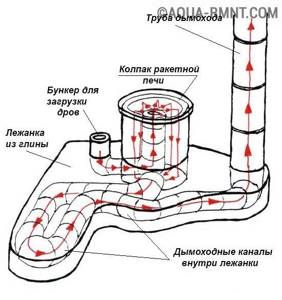
Scheme of a jet stove with a stove bench
This idea found its implementation in massive stationary structures with a couch in the shape of a sofa or bed. It is successfully made from brick or rubble stone, decorated with a plastic mass of clay and sawdust. Thanks to the high heat capacity of the materials used, the stove can retain heat all night, which, combined with high efficiency, makes the heating unit very attractive for installation in residential premises.
When choosing a design for manufacturing at home, you need to take into account the features of its operation. As a camping option, choose a mobile unit - it will be enough to warm up, dry clothes and cook lunch. In order to occasionally heat small technical rooms, a portable structure made from a gas cylinder is used. If you need to heat a small country house or cottage, then there is simply no better option than a jet heating unit with a stove bench.
Operating principle and design advantages
The name of the device speaks for itself. Indeed, the operating principle of such a furnace is reminiscent of the functioning of a rocket engine running on solid fuel. Briefly it can be described as follows:
- Firewood and coal are placed in a vertical bunker, after which the hot gases rise upward.
- The gases enter the so-called afterburning zone - here they undergo secondary combustion due to the highly heated space.
- Afterburning is facilitated not by primary, but by secondary air entering through an additional supply channel.
- Next, the gases follow a complex system of chimneys, which are installed in permanent structures in order to completely warm up all rooms.
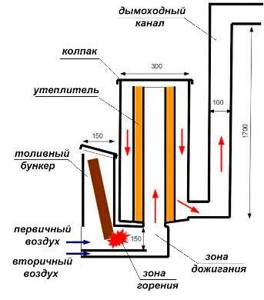
This design provides quite a few tangible advantages compared to a conventional oven:
- Gases are burned completely - virtually no intermediate combustion products are formed. This allows, on the one hand, to extract maximum energy from the fuel. On the other hand, carbon dioxide and water do not clog the internal surfaces of pipes and chimneys, making them much easier to clean.
- Thanks to an extensive, fairly extensive chimney system, one stove can heat an entire house of standard sizes (100-150 m2). In addition, the heat from heating lasts 6-7 hours.
- The design is safe, since the risk of penetration of combustion products is eliminated - all intermediate products are completely oxidized by air. Thus, carbon monoxide does not form in the oven, it turns into carbon dioxide.
- You can assemble the structure quite quickly and essentially free of charge - for example, from an ordinary pipe or an old empty gas cylinder, a rocket stove can be constructed in a few hours. The simplest options are shown in the photo.

The stove is multifunctional: despite the simplicity of the design, it is capable of not only heating the room, but also allows you to cook food, and if desired, you can also provide a warm sleeping place. The figure shows a camping option, which provides the ability to cook food in the field.
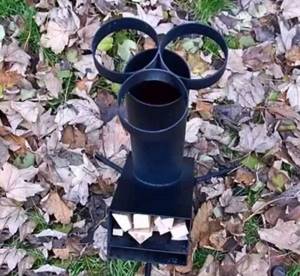
Of course, this design has certain disadvantages, but they are few:
- First of all, a flared rocket should not be left unattended - but strictly speaking, this rule applies to all stoves. If the gases create too much pressure, the heat can increase rapidly, potentially causing a fire.
- You should not put even barely damp wood into a jet stove. Due to water vapor, intermediate combustion products will not be able to burn out to the end, as a result, backdraft will occur and the flame will weaken.
- Finally, in the case of a bathhouse, a rocket will not work. This means that the design is not suitable for a steam room, which is heated by infrared radiation. But the rocket produces clearly not enough radiation of this kind.
A visual description of the rocket furnace structure can be seen here.
Types of rocket stoves
In this section we will look at the most common types of rocket stoves used in field and stationary conditions.
Simple metal stoves
The simplest wood-burning jet stove is made from an L-shaped piece of large-diameter metal pipe. The horizontal part is short, it represents the firebox. The combustion chamber is located in the vertical part of the pipe, where wood actively burns. A small metal plate is often welded into the horizontal section, forming a blower. After warming up, the rocket furnace enters operating mode, and a flame bursts out of its vertical section (flame tube).
Such rocket stoves are used for cooking food in camping or outdoor conditions - due to their small area, they produce little heat, and the vast majority of the thermal energy is lost through the fire tube. Kettles, frying pans and pots are placed on this pipe so that the raging flame ensures their heating. To maintain traction, there are stands in the upper part of the pipe, on which the dishes are placed - combustion products can freely come out.
To make a metal rocket furnace made from an L-shaped piece of pipe more efficient, it is equipped with a metal casing made from an old barrel. A blower can be seen at the bottom of the barrel, and a fire tube peeks out from the top. If necessary, the internal volume is filled with insulation, for example, ash - it does not burn and retains heat well.
Metal rocket stoves with vertical fireboxes located at an angle to the flame tube are the most convenient. Often the combustion openings are closed with lids; in this case, air is taken through the ash pan. Sometimes the firebox is made larger in diameter than the flame tube to ensure long-lasting combustion.
Simple brick ovens
A small-sized brick rocket stove is another simplest option for building a rocket stove with your own hands. Its assembly does not require cement mortar; it is enough to stack the bricks on top of each other to get a convenient brick outdoor unit for cooking at your disposal. In the section on self-assembly of rocket stoves, we will invite you to familiarize yourself with the simplest procedure for self-assembly.
A rocket stove, made with your own hands from brick, can be used to heat households. In this case, a simple arrangement is not enough - you will have to build a stationary version using a special cement mortar. There are many procedures for this, you just have to choose the appropriate option. By the way, some versions of such furnaces include a water circuit.
Advantage of brick rocket kilns:
- Simple design;
- Long-term heat retention;
- The ability to create a comfortable warm bed.
Some models are made combined, using both steel and bricks.
Sophisticated rocket stoves
A jet stove for heating households or for a bath is characterized by increased complexity. The main link here is still the riser (fire tube), enclosed in a metal casing. Its upper part can be used for cooking, forming a kind of cooking surface. The firebox is made large to accommodate an increased amount of solid fuel. The starting materials are metal, bricks and clay.
Based on clay coating, streamlined rocket furnaces of irregular shape are made, which is well perceived by human vision.
There are projects for wood-burning rocket stoves that include additional modules. Their construction schemes include small boilers for preparing hot water, hobs, water jackets and even small ovens. Such stoves will help heat households and create comfortable living conditions for people.
A rocket boiler with a water jacket, created on the basis of a wood-burning stove, will help warm up a multi-room building. It is equipped with a water circuit for heating the coolant. Additional convenience is created by samples with beds - these beds are created on the basis of thermal channels between the flame and chimney pipes.
How to do it yourself?
Before you make a rocket stove, you need to decide on the location of its installation, the dimensions of the future design, and develop a diagram. The masonry technology itself is quite simple; any novice builder can master it.
The simplest design of a rocket stove can be built from 20 bricks at a summer cottage and used to heat food brought from home.
Selecting a location
Before starting construction, the first thing is to choose a location. It is recommended to place rocket-type brick stoves closer to the front door. In this case, after cleaning, the ash will not need to be carried across the entire room, which will have a positive effect on the overall dustiness of the room.
It is also desirable that at the point where the pipe exits there are no rafters located closer to the chimney than 40 cm. And yet, the stove should not be adjacent to the external wall of the house, so that expensive heat is not lost to heating the street.
Preparation of the solution
Cement mortar will quickly crack under the influence of high temperatures, so for laying heating devices made of bricks, only a mortar consisting of clay and sand is used.
Their proportions are determined experimentally, depending on the quality of the clay. Most often in a ratio of 1:2 or 1:3, and the higher the fat content of the clay, the less it is added to the solution.
First, the clay must be soaked, strained, and then sand must be added. The resulting solution should have a consistency similar to thick sour cream. You can check its viscosity level in the following way:
- place a wooden stick or trowel handle into the mixture;
- remove the tool and shake well;
- check the thickness of the adhering layer: if less than 2 mm add clay, more than 3 mm add sand.
The preparation of the mortar must be approached with all responsibility, since only a plastic mixture of the required thickness can fill all the unevenness of the bricks and ensure their strong adhesion.
Ordering a rocket stove for 20 bricks
Example of a brick rocket stove
Rocket stove from a gas cylinder: drawings, photos, videos
Rocket stove made from a propane cylinder: drawings, photos, videos. Step-by-step making of a stove from a gas cylinder with your own hands.
In a previous publication, we looked at the assembly process of a traveling-type rocket stove; the rocket-type stove design makes it possible to obtain the maximum permissible output of heat energy by post-combustion of gas-generating gases formed during the primary combustion of wood.
A rocket stove can also be used for heating rooms, cottages, and garages; in this article we will consider the design of such a stove made from gas cylinders.
In order for a rocket-type stove to heat the room well, it is necessary to additionally construct a chamber for afterburning gas-generating gases; in this way, the heat transfer of the stove becomes significantly greater and the fuel consumption will become less.
As a container for afterburning pyrolysis gases, you can use a simple propane gas cylinder, the diameter of the cylinder is 300 mm, the height is about 900 mm, such a container is excellent for the production of a rocket-type stove with afterburning gas generator gases.



